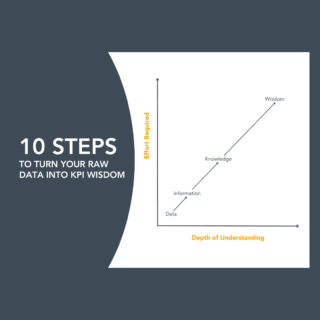Four simple steps to improve the execution and performance measurement of your strategic goals
Want your teams to deliver more impact and do less “busy work” in 2017? Then K.I.S.S. (keep it simple and specific) your goals!
Why is it important to keep your goals simple?
- Easier for teams to connect to emotionally (and care about achieving)
- Easier for teams to find a meaningful performance measure (and get the evidence-based feedback they need)
- Easier for teams to be agile when looking for high ROI actions (and do less busy-work)
As smarty-pants physicist Einstein said:
“If you can’t explain it simply, you don’t understand it well enough.”
How do you do it? Follow these four steps:
KISS STEP 1: Start with the end in mind. That means your goals can’t be actions or vague improvement initiatives.
Try this instead: Articulate the Impact. Use the following questions to help your team start with the end in mind:
- Why are you doing this action or improving this area?”
- What are you actually trying to achieve?
The most useful, strategic goals are actually “results” that describe the impact you want from your actions and continuous improvement.
For example: Goals are often written like this: Develop an HR Strategy by June 2017 or Improve Staff Engagement. In reality, one goal is actually just a tactic or action, and the other is an improvement initiative (not goals at all).
So you need to ask: Why do we need an HR Strategy? Why do we need to improve staff engagement? That will lead your conversation to something much more important – what you are trying to achieve (see next step).
From your team’s point of view, can you see how much more strategic their conversations and work choices will be when they are clear on what they want to achieve vs. what they simply think they should do?
KISS STEP 2: Write your goals in plain language that a 5th grader can understand. That means your goals can’t use fuzzy language and corporate jargon such as efficient, effective, productive, sustainable, quality, support, world-class, leading-edge, collaborate and the list goes on.
Try this instead: Use concrete, plain language that you can observe happening in the real world and that a 5th grader could understand.
For example: Improve Staff Engagement has what I call the mother of all fuzzy weasel words: “engagement”. Why? Because “engagement” could mean a multitude of different things and it does not describe what you actually want to achieve by “engaging” staff.
So ask: What does staff engagement look like in your workplace? What would you observe when staff are “engaged”? And what does your organization want to achieve by engaging staff? Some possible examples might look like:
- Employees do more than what is expected of them
- Employees say they love coming to work
- Employees work towards the success of the company
- Employees take less sick days on Fridays
- Or does it mean something completely different in your organization?
From your team’s point of view, can you see how it would be easier to connect to, act on, and find a meaningful performance measure for?
KISS STEP 3: Be truly specific. That means you have to stop bundling a bunch of priorities into one goal statement.
Try this instead: Keep each goal focused on one idea/one priority.
For example: It is common for a goal to be written like this: Improve the quality and the relevance of our products and services.
You would need to separate out the goal to be truly specific:
- Improve the quality of our products
- Improve the quality of our services
- Improve the relevance our products
- Improve the relevance of our services
From your teams’ point of view, can you see how different actions and performance measures would be needed for each? (And hopefully you’ve noticed, you still need to apply KISS steps 1 and 2 above)
KISS STEP 4: Ruthlessly Prioritize. That means you have to stop leading like everything is equally important now.
Try this instead: Apply the research that reveals that people don’t actually multi-task that well. More gets done when they have 1-3 goals to focus on at a time vs. four or more. Prioritize using team developed criteria or the results mapping technique introduced in last months’ blog. Focus where the performance gaps are the biggest, or where a performance gap is impacting the customer experience significantly.
For example: if you take the goal from Step 3 (preferably after you de-weaseled “quality” and “relevance” and turned it into a result statement), you could then assess which of these results is most important to address first and why.
From your team’s perspective, can you see how they would benefit from knowing what is strategically most important, what they need to find a meaningful performance measure for, and then focus just on that until sufficient progress is made?
What other techniques have you used to get teams to deliver on the results that are strategically most important? Contact me with your examples.
This step-by-step approach to translating goals into plain language results is based on a tool called the Measurability Test created by Australia’s performance expert Stacey Barr. It is part of an 8-step process called the PuMP® Performance Measure Blueprint. Louise Watson of Adura Strategy is Canada’s Official Partner and Licensed PuMP® Blueprint consultant and uses this approach to improve strategic execution and organization’s performance measurement process.



